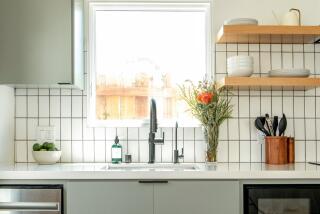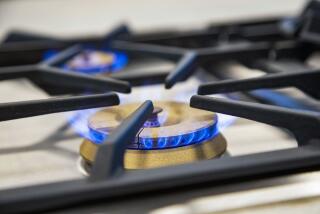A New Theory of Evolution
- Share via
If anthropologists thousands of years hence seek to understand changes in residential living in America at the close of the 20th century, they would do well to focus on the kitchen. Its evolution illustrates the vast changes in lifestyle and living standards better than any other element of home design.
In a way, the kitchen has come full circle. Over the last 300 years, it has been transformed from spare and unadorned to sumptuous and high-tech, from a place where family gathered around the hearth in colonial times to the last place on earth the Victorian matron would dream of entertaining, to today’s open, multi-task kitchen, where friends and family gather to celebrate and relax. It has wandered from inside the home to outside and back in again.
For the record:
12:00 a.m. June 6, 1999 For the Record
Los Angeles Times Sunday June 6, 1999 Home Edition Los Angeles Times Magazine Page 6 Times Magazine Desk 1 inches; 22 words Type of Material: Correction
In “A New Theory of Evolution” (Special Millennium Issue/Home & Design, May 16), the photograph on Page 32 should have been credited to Eric Staudenmaier.
In the early decades of the 20th century, an explosion of electric-powered advancements meant that by the ‘20s, a woman could have any number of kitchen helpmates--an icebox, washing machine, electric iron. By the ‘30s, most middle-class homes had an electric stove and refrigerator. Suddenly the kitchen became a darling. Families were proud of their colorful, conveniently arranged cooking set-ups, and the addition of each new electric appliance was a measure of success. “Just as the Victorians considered the parlor as a reflection of their social standing,” explains kitchen historical expert Ellen Plante, “the early modern decades saw the kitchen take on this role.” It was evolving as the most important room in the house.
As the kitchen changed, so too did the time spent on food preparation--from the early Victorian era, when nearly everything was made from scratch, to canned, boxed and frozen goods that filled cupboards and refrigerators in the ‘50s, to today’s frequent reliance on takeout and local gourmet delis and the speedy microwave oven. Introduced in the 1950s but not found in most homes until the late ‘70s, the microwave is the single most significant development in kitchen convenience over the last 50 years. And with the computer age, amazing new domestic technologies are underway for the 21st century.
THE VICTORIAN KITCHEN
The advent of new technology began to ease the burden of kitchen duties and influence the shape of the kitchen. “It was the height of convenience for the Victorians when plumbing lines were introduced in the second half of the 19th century,” says Ellen Plante, author of “The American Kitchen, 1700 to Present.” In place of the kitchen pump and bucket were mass-produced cast iron or granite sinks with faucets that ran hot and cold water. But that cast-iron stove first introduced in 1850 was temperamental and dirty and needed regular stoking with coal or wood. When the first gas stove, the Sundial Range, was introduced in 1879, its four burners, oven and open broiler epitomized luxury. Its clean-burning fuel eliminated the ashes, grime and heat of a coal/wood-burning range.
As for keeping things cold, refrigerators first introduced in the 1860s had become commonplace in middle-class homes by the 1890s. But those oak iceboxes required constant replenishments of ice. With the introduction of gas, kitchens moved from the outbuilding or basement back into the house--typically to the rear of the first floor. Yet it remained the least-decorated room in the house.
In the 1890s, as domestics were lured to the factories of the Industrial Revolution, the Victorian housewife was forced to play a more active role in the kitchen. Her increasing status as a consumer in the 1900s spurred additional advances in appliances, packaged goods and myriad helpful gadgets: cherry stoners, apple peelers, lemon juicers, sausage stuffers and coffee grinders. The 1890s also gave rise to the free-standing baker’s cupboard, the forerunner to Hoosier cabinets, which had pullout work surfaces and bins for flour and sugar. Pie safes, which were perforated tin cupboards, kept away flies and other vermin. “And for the sanitary-minded Victorians,” says Plante, “no urban kitchen would have been complete without a live-in hedgehog, who slept by day and devoured cockroaches by night.”
MID-CENTURY
After World War II, the suburban housing boom formalized the trend for the built-in kitchen. Developers began featuring kitchens at the front of the house--to reflect the room’s new status. Often just a step from the front door, it served as a “domestic control center,” and the stay-at-home mom was viewed as its chief “domestic engineer.”
At this time, the kitchen began to partly open up to the rest of the home and expanded to contain not only cooking, eating and laundry but also a sewing area and an office nook. Kitchens were often built in U- or L-shaped plans with linoleum floors and Formica or stainless-steel counter tops. Many featured eat-in kitchens with colored, plastic-topped dinette sets, vinyl-covered chairs and a sink under a window so mom could watch the kids. The byword of the era was “togetherness.”
Appliances came in an array of pastels--turquoise, petal pink, canary yellow. General Electric offered Textolite counter tops compatible with its mix-and-match colors. “A product might not really be new and improved, but if it looked different and exciting, it was more likely to be bought,” explains author Thomas Hine, whose book “Populuxe” examined life in America in the ‘50s and ‘60s. Stoves from the early ‘50s included electric double-ovens with high back splashes and fingertip control panels with names such as “Stewardess” and “Airliner.” “Space Age” kitchens featured built-in ovens, counter-top ranges and push-button temperature controls. GE’s “Spacemaker” refrigerator, with its large storage capacity and compact shape, was a big hit, as was a model that featured easy-to-open-and-shut magnetic doors. Appliances and built-in cabinets that had featured a curved streamline design were now flatter and boxier.
A host of smaller electric appliances appeared, from electric can openers, blenders and beaters to a four-slice toaster. Dishwashers and garbage disposals were available but had not caught on. “Appliances were no longer seen as merely objects in the kitchen,” says Hine. “Rather, they were the kitchen, thus appliances were increasingly built-in.”
‘90s KITCHEN
Today the kitchen often encompasses the dining and living rooms at the center of the home, readapted to meet the needs of busy families. Any family member might do the laundry, grocery shopping or cooking. “It’s not only a place to eat and prepare food but to entertain friends, do homework, pay bills, watch the news,” says Kevin Henry, director of sales and marketing for Snaidero U.S.A., the largest importer of Italian kitchens. Indeed, home controller systems, such as IBM’s Home Director, manage everything from home security and energy use to light switches and appliances.
The kitchen also has become a hub where several family members can help with meal preparation and chores. As a result, options in the ‘90s kitchen are vast. Cooks may choose electric or gas burners, or opt for gas burners with an electric oven. Some cooktops include grills, wok burners and high-heat griddles. Quick-start elements that glow hot with a press of your finger, such as Dacor’s Touch Top, offer smooth, ceramic glass tops that are easy to clean. A single oven can feature standard bake and standard broil, convection, pure convection and convection bake. Multi-rack cooking in convection ovens allows you to roast a chicken, bake a sheet of chocolate chip cookies and heat a tuna casserole at the same time.
Refrigeration comes in a range of styles and sizes, including side-by-side, top-freezer and bottom-freezer, and the latest from Sub-Zero: under-cabinet drawers that may be in different zones of the expanded, open-plan kitchen. Many of today’s refrigerators are hidden behind cabinet-matching facades, such as the Sub-Zero 700 in Snaidero’s Viva kitchen, which resembles a free-standing piece of furniture, or stand out in stainless steel, white or black, or the newly emerging color, biscuit.
In addition, these appliances are being arranged to create a more user-friendly environment and enjoyable place to spend time. Instead of being clumped together for easier accessibility, the stove range and oven are often spread out around the room, so both mom and dad can cook. Dishwashers and refrigerators may be hidden behind decorative panels for a fully integrated look and run so quietly that you cannot hear them. Miele’s Novotronic dishwasher, says Mary Anselmo, showroom manager of Miele Appliances in Beverly Hills, “is quieter than the sound of boiling water.”
The look of today’s kitchen, like contemporary homes in general, is highly personalized. It ranges from high-tech to traditional--and features a palette of natural and synthetic products from marble, granite, limestone and maple butcher block to plastic laminates and vinyls that resemble the real thing. Euro-style flush mounted cabinets with concealed hinges have helped give today’s kitchens a stylish, seamless and fitted look.


